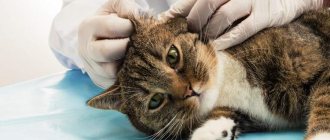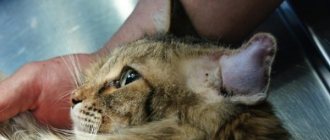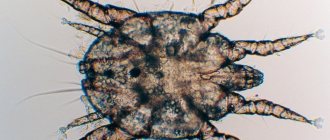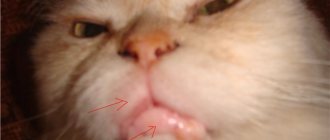Features of the structure and development of the parasite
Ear mites in cats are an arthropod parasite whose length reaches 0.5 mm. Its body looks elongated, has an oval shape, and a yellow tint. The tick goes through a development cycle of 20 days, then lays new eggs and dies. Itching and discomfort in the animal occur during the period of activation of the eggs.
Ear mite
Important! A cat's ears are a favorable environment for the parasite to survive. They accumulate a sufficient amount of moisture and heat. Earwax does not prevent the pathogen from colonizing; it survives and feeds on it.
The pathogen spreads through the tissues of the ears, laying eggs in them. At this moment, acute itching begins, due to which the cat scratches its ears, until blood appears. An adult tick damages the skin and mucous membranes and sucks blood. In the process of life, it releases waste and toxins. Their accumulation leads to activation of the immune system, which results in an acute inflammatory process. Excessive amounts of sulfur and swelling appear, which reduces hearing.
The parasite develops from eggs. This usually happens in the spring. Young individuals appear, which increase in size as they grow older and consume blood and lymph. When they reach the adult stage, they begin laying eggs again. The mite does this in the outer layers of the epidermis.
Are ear mites dangerous for humans?
The danger that ear mites bring to humans can have the following consequences:
- the patient may have inflamed sebaceous glands - demodicosis;
- ticks are carriers of viral and infectious diseases;
- parasites are a breeding ground for microbes;
- arags mites carry borreliosis, typhus, and relapsing encephalitis;
- parasites can introduce spores of any fungus into the human body.
At the first symptoms of tick infestation, you should go to the hospital for medical help. The faster you react to the possibility of infection, the faster and easier it is to transfer the disease.
How can an animal become infected with ear mites?
The source of the disease is infectious animals. Close contact is required for the parasites to penetrate the cat's fur. Along it they spread to the outer ear area, where the reproduction cycle begins. Without a host organism, the tick quickly dies in environmental conditions. He needs no more than 2 months for this.
Scabies in cats: mite, treatment at home
Examination of a cat with ear mites
Both an adult and a kitten can become infected. In addition to close contact, ear mites in cats can be transmitted through contact with the following objects:
- combs;
- animal houses;
- toys;
- not sterile instruments from veterinarians;
- carrying;
- a person who has carried the parasite on clothes, hands, shoes;
- an insect that carries microscopic eggs or young.
The reproduction and life cycle of ticks begins in the spring. It is during this period of time that it is dangerous to take a cat outside, as it comes into contact with other individuals. Ticks can even spread through grass after an infected animal passes through it.
Attention! Ear scabies are more common in young individuals. Cats do not always become infected. This is preceded by a decrease in the function of the immune system and the presence of a recent illness.
Diagnosis of ear mites in cats
The optimal diagnostic method involves visiting a veterinarian and taking skin scrapings for laboratory examination.
If you contact a veterinarian in a timely manner, treatment takes 2–4 weeks. This long range is due to the fact that you will not treat your cat until the mite breeding cycle is broken.
While the adults are destroyed, their eggs remain in the skin and become a source of re-infestation. Experience shows that if you follow the veterinarian’s recommendations, a significant improvement in the clinical picture occurs after 1-2 treatments.
Note! As part of treatment for ear mites, the veterinarian may prescribe not only antiparasitic drugs, but also antihistamines. This step is necessary if the cat is very itchy and has scratches and wounds on the head. An antihistamine reduces the acute immune response to tick saliva, which symptomatically eliminates itching.
Symptoms of infection
Scabies in the ears of cats is accompanied by characteristic clinical symptoms. Most often found:
- anxiety of the animal, it begins to twitch, rub its ears, behave aggressively, rub against people’s legs, household objects;
- within 1-2 weeks, a brown or yellow discharge appears from the ears;
- a putrid smell appears;
- if there is no treatment within 2 weeks, the pet becomes lethargic, tired, sleeps a lot in between itching;
- at week 3, hearing begins to gradually decrease, after 1 month it may be completely absent;
- a sharp increase in the amount of sulfur, which forms traffic jams;
- Bloody wounds covered with yellow crusts appear in the ears from constant scratching.
Ear mites in cats: drops, treatment, effective drugs
Important! Sometimes pus, crusts and wax plugs so close the ear canal that a person cannot eliminate the pathological process on his own. Therefore, ear mites in cats cannot be cured without the intervention of a veterinarian.
How to treat ear mites in cats
Otodectosis is a dangerous disease, but in the initial stages it can be easily treated. It is important not to miss the disease and contact the veterinarian on time. There is no need to diagnose and treat the animal yourself, as this can only aggravate the disease and waste precious time - the disease can move to the next stage. Recognizing the symptoms and treating ear mites in cats is the responsibility of different people. The owner of the animal is responsible for the timely detection of symptoms, and the veterinarian is responsible for the correct treatment.
Ear mites in cats photo and treatment
Today in veterinary medicine there are a lot of drugs to combat ticks. They are available in the form of aerosols, ointments, drops and powders. The first signs of ear mites in cats indicate the initial stage of the disease. During this period, the doctor may prescribe “Amit”, “Amitrazine”, “Tactic”, “Acromectin”, “Amitraz”.
Cats affected by ear mites are extremely irritable and it is difficult to imagine them sitting still during ear treatments. Many of them do not even allow you to touch your ear, let alone give you the opportunity to clean it. Taking this into account, special preparations were developed in the form of aerosols (based on “Tsiodrin”, “Acrodex”, “Dermatozol”). They can be sprayed next to the ear, approximately 5 cm from the auricle, and the particles of the medicine will fall into the right place on their own.
When using drugs, it is necessary to take into account the age of the cats. For example, what is successfully used to treat adult cats may not be suitable for kittens, although kittens under 6 months of age are most at risk of the disease. If the instructions do not indicate contraindications, then the medicine can be used. Many medications are contraindicated for pregnant cats.
Important
The dosage of all medications must be determined by a veterinarian.
Intramuscular administration of antiparasitic drugs is resorted to in the later stages of the disease, when drops and ointments alone are no longer sufficient. In this case, an effective cure for ear mites in cats is Otodectin.
As for the treatment procedures themselves, they are simple. You can do them yourself, after a specialist shows you how it should look ideally and what you should pay special attention to.
Treatment of the ears with medications can begin only after preliminary cleaning. This can be difficult to do, as it causes pain in cats and they try to escape from the owner’s hands. However, it is necessary to clean the ears of pus, the mites themselves and their waste products, because only in this case the medicine will have maximum effect.
Cleaning the ears is carried out with cotton swabs or disks soaked in camphor alcohol, chlorhexidine or 2% hydrogen peroxide solution. It is the peroxide that will soften the scabs and make the process of removing them easier. After cleaning, drops are instilled into the ears or lubricated with ointment in strict accordance with the veterinarian’s recommendation or according to the instructions for the drug. To ensure that the drops or ointment are evenly distributed throughout the ear, you can lightly massage the ear at the base.
Ear mites in cats photo
Most of these procedures are done only once a day. This is enough for the ticks to gradually die and the wounds to heal. It is recommended to carry out treatment from a week to ten days, but no less, even if after the fifth time your pet’s ears will look perfect. The treatment process must be completed to the end, this is the only way to achieve results and avoid relapse of the disease.
Any treatment for ear mites in cats may affect the animal differently. If it helped one cat cope with the disease, then the other will remain immune to it. Therefore, an individual approach is important here. It is impossible to visually determine whether the tick was 100% controlled, therefore, to ensure the effectiveness of the drug, it is advisable to undergo a laboratory test. To do this, a scraping of the contents is taken from the cat's ear and a microscopic examination is performed. If the analysis shows that there are no mites, treatment can be stopped.
When fighting ear mites, we must not forget about other areas of the skin that can become a habitat for parasites, so it is important to treat the entire skin of the animal with antiparasitic drugs.
Drugs for the treatment of ear mites in cats can be primary or secondary.
The first are antiparasitic, and their action is aimed at destroying the tick.
The latter are designed to have a calming effect, alleviate the general condition of the animal, and relieve itching and irritability. Otonazole drops intended for instillation into the ears are perfect for this. They will speed up the healing process and relieve inflammation. Also auxiliary are ointments containing sulfur compounds. For example, “Sulfur ointment”, “Vishnevsky” and “Colloidal sulfur”.
How to get rid of ear mites in a cat if the disease is in an advanced stage? In this case, in addition to injections, the veterinarian may prescribe antibiotics, but this only happens if complications arise in the form of a secondary bacterial infection.
Diagnostics
Rhinotracheitis in cats: symptoms and treatment at home
You can recognize the presence of ear mites in a cat yourself. To do this, take a sterile cotton swab, but a cotton swab is better. Wear gloves so as not to subsequently transfer the pathogen with your own hands. A cotton swab is inserted deep into the animal's ear. You should take a smear containing earwax, pus, and microorganisms.
Examination by a veterinarian
The contents of the cotton swab are shaken onto paper. A bright light is directed at it, examined through a magnifying glass. The parasite should be separated from the earwax. If yellow dots appear on the paper and move around, this is a clear sign of mites.
The veterinarian does the same diagnostic process. But unlike at home, he will be able to examine the pathogen under a microscope, accurately determining its classification.
Ticks under a microscope
If pus appears in the ears, this is a sign of a microflora disorder. Due to the presence of mites, pathogenic microflora multiplies in the cat's ears. Therefore, they take a smear and send it for bacteriological culture. Identify the exact bacteria and the antibiotic to which they are sensitive.
Diagnosing ear mites in cats
In the typical form of otodectosis, self-confirmation of the diagnosis is allowed. The disease occurs in several stages:
- Primary infection - grains or stains of a dirty brown color are observed in the ear folds.
- Acute form - the auricle is generously coated with brown “mush”, the consistency is most often wet with fragments of earwax. When an animal scratches its ear, a characteristic “smacking” sound is heard. If you run a finger or a cotton swab along the inner surface of the ear, a reaction from the hind legs is observed - tremor, imitation of scratching. A similar reaction to stroking from the outside indicates sarcoptic mange (subcutaneous mite) or notoedrosis.
- Complicated form - there is pus, blood or black-green patches in the ear. Touching causes pain, the animal shakes its head. This degree of damage is most often accompanied by secondary symptoms - nasal discharge, tearfulness, severe scratching of the head.
In terms of general information, it is worth knowing why ear mites are dangerous in cats:
- Epidemiological spread - the carrier infects all animals with which it comes into contact.
- Scratching, self-injury, up to hematomas and traumatic brain injuries.
- Spread of the lesion to other parts of the body (tail, croup, neck) if the cat likes to sleep in a ball.
- Inflammation of the lymph nodes, as a result of a decrease in the level of the body's immune defense.
- In complicated forms - deafness, central nervous system disorder, inflammation of the mucous membranes of the eyes and nose, spillage of pus in the soft tissues of the head.
Let's figure out how to determine the presence of ear mites in a pet. You will need: a cotton swab, a sheet of black paper, a bright light, if you have vision problems - a magnifying glass. Algorithm:
- We open the animal’s ear, take a cotton swab and in one movement grab the maximum possible amount of plaque (mush).
- Hold the cotton swab over a sheet of paper and gently tap the plastic base with your finger.
- We put the stick next to it and look carefully at the leaf. You are interested in a white dot, 2-3 times smaller than a grain of semolina porridge. The dot was found, lay in place, and then began to move - bingo! It's an ear mite!
- We roll up the sheet and throw it away, and then we go to the pet store or to the veterinarian for advice.
Ear mites in cats: stages of the disease
During the development process from egg to adult, the parasite develops several stages of damage.
- Microcracks or major trauma to the skin and mucous membranes form in the ears. The parasite penetrates this area, damaging the epidermis. Through the hole it has access to blood and lymph, which it feeds on. During their life, mites secrete toxic products, which cause severe itching and other immunological reactions.
- Damage to the walls of blood vessels with the formation of swelling and redness of the affected area.
- Purulent discharge may form on the skin due to the development of an immune reaction.
- Exudate together with waste products of the mite form brown scabs. Pathogenic microflora begins to multiply, resulting in increased inflammation and suppuration.
- A crust accumulates in the animal's ears. It blocks the passage, which causes decreased or absent hearing.
Attention! If the infection is not treated in a timely manner, the pathological process spreads all the way to the eardrum and inner ear.
Description of ear mites in cats
This parasite has some peculiarities. For example:
- Ear mites are quite small in size. This is a tiny arthropod that causes nothing but trouble for your pet.
- Adult parasites reach a length of 0.2 to 0.6 mm. The body is oval in shape and light yellow in color.
- The parasite lives for about 20 days. During this period, it manages to actively reproduce.
- Cats' ears are quite warm and humid, which is the main condition for the parasite to survive.
- As a result of the activity of mites, a lot of their waste accumulates in the animal’s ears, which leads to excessive release of wax and inflammation of the auricle.
Ear mites, despite their tiny size, are highly resilient. Outside the animal's body, without food, it can live for about 65 days, and only after that, if it is unlucky and does not find its victim, the tick dies.
It is necessary to distinguish between 2 types of ticks:
- Ototdectes cynotus. This type of parasite prefers to settle inside the ear, causing the disease otodectosis or ear scabies.
- Notoedres cati. This type of mite is located on the outside of the animal's ear, causing the disease nodtoedrosis.
Reasons for appearance
This type of parasite, which provokes inflammatory processes on both the inner and outer sides of the ear, appears in various ways. At the same time, the cat does not have to take walks in the yard. He can become infected as a result of harmlessly observing the events taking place on the street from a window. But still:
- Animals often become infected while walking outside. Parasites can be found in grass, garbage, basements, attics, etc. Cats are quite inquisitive animals, and they often visit such places, after which they become infected with ear mites.
- Contact with stray animals also leads to this type of infection. In addition, children can also come into contact with stray or neighbor cats, after which they can infect their pet with these parasites.
- If the rug at the front door has not been washed or treated with a disinfectant for a long time, then this place is a temporary refuge for many parasites, including ear mites. Moreover, if you practice walking around your apartment in dirty shoes, this increases the risk of many parasites entering your home.
Signs of ear mite infestation
You can determine the appearance of ear mites in a pet by a number of external signs. For example:
- The cat shows concern and shakes its head, as if trying to free itself from some kind of burden.
- A dirty brown liquid with an unpleasant odor is released from the animal's ears.
- The inside of the ear has a red, irritated tint.
- Sometimes the body temperature rises and by its appearance it can be determined that the animal is unhealthy.
- Hearing may be lost.
- The release or accumulation of large volumes of sulfur is also observed.
- With poor pet care, cats' ears become clogged with wax and clots of parasite waste. As a rule, the animal suffers greatly from this.
On a note ! If the owner of a pet pays little attention to it, then the form of the disease is very neglected, as evidenced by veterinarians. In this regard, they recommend regularly examining the ears of pets, especially if the cat is behaving rather strangely.
Danger of disease
In the absence of proper care for the animal, much less appropriate treatment, very serious complications are possible. For example:
- Possible inflammation of the skin.
- In some cases, hearing loss may occur.
- Constant itching irritates the animal, which leads to noticeable discomfort.
- The animal, trying to get rid of discomfort, scratches its ears and scalp, which leads to the appearance of open wounds.
Diagnostic methods
You can see for yourself that your cat is suffering from ear mites before visiting the veterinarian. To do this, you need to take cotton swabs and dark material, since it is unlikely that you will be able to see these parasites on light material. Further actions are as follows:
- Use a cotton swab to grab and pull out the animal's discharge from the ear.
- Bring the stick to the dark base and shake off the ticks from the stick.
- A bright light is directed onto the dark base, a magnifying glass is taken and the parasites are examined through it. If barely noticeable but moving dots of a light, yellowish or cloudy white hue appear, then the fact of infection is obvious.
After this, it is advisable to visit a veterinarian who will tell you the right way to rid the animal of parasites. The effectiveness of treating a pet for ear mites depends on the timely visit to the veterinary clinic. Even when using traditional methods, it is advisable to consult a doctor.
Ear mites in a cat
Medicines against ear mites in cats
To completely remove mites from cats' ears, it is recommended to use a medication. If they are not used, the pathogen may remain inside the ear canals. Since the parasite goes through several stages of development, a single use of medication may not help. Therefore, they are used repeatedly to destroy new individuals that have developed from eggs.
Ear drops
Treatment is carried out in several stages.
- Cleaning the external auditory canals from crusts, pus, scabs, and earwax. A veterinarian can help with this. In his office, he completely cleans the ear canal using special tools.
- Cleaning with antiseptics. A solution of furatsilin, chlorhexidine, and hydrogen peroxide will help get rid of bacteria and toxins. They not only destroy pathogenic microflora, but also wash out a certain proportion of parasites. The product is applied to a cotton swab. Directly pouring the solution into the ear is prohibited.
- Use of anti-tick medications. They are used in the form of ointments, drops, and gels. It is recommended to use drops during the daytime. They are applied strictly according to the instructions, up to three times a day. It is recommended to apply ointment or gel at night so that the drug has a long-lasting effect. They use Amitrazine, Tactic, Otoferonol.
- When the pathogen spreads strongly in the eardrum or inner ear, injectable drugs are used. One of them is Ivermectin. It is used only in extreme cases, since the active substance penetrates the liver and causes the destruction of some hepatocytes. Therefore, during therapy, biochemical blood tests are periodically taken to determine liver enzymes. You should follow the step-by-step instructions to avoid adverse reactions.
- Antimicrobial drugs with anti-inflammatory effects. One of them is Otonazole. The ointment not only has a bactericidal effect, but also treats fungal infections. It is used for active reproduction of pathogenic microflora.
- To relieve itching and eliminate the possibility of mites actively reproducing, oils and creams are used. They soften the skin and crusts formed on wounds. After their application, it is easier to remove foreign objects from the ear canal.
- Immunotherapy. They use Gamavit, Gamapren. They stimulate the synthesis of the cat’s own immune cells, thereby enhancing the destruction of pathogenic microorganisms. The animal is able to fight the infection on its own.
In addition to medications, diet is used during treatment. The pet's diet at this time should be varied. It should include all the beneficial substances, microelements, vitamins, and minerals necessary to strengthen the immune system.
Important! Cat ear mites can spread indoors. Therefore, from the moment parasites are identified, all household items are thoroughly disinfected. This eliminates the risk of re-infection.
Preparations for the treatment of ear mites in cats
To treat ear mites, there are many different preparations in the form of powder, sprays, drops, ointments and lotions.
Complex drops
To treat ear mites, complex drops are used that are applied to the withers. The effect of the drug begins after its distribution in the deep layers of the skin or absorption into the blood lymph. Typically, the use of such drops involves several treatments with a break of 7 to 14 days.
Amitrazine
Amitrazine is widely used in veterinary medicine because it has a triple therapeutic effect. Drops help fight infection, fungal infections and subcutaneous mites.
Amitrazine is considered a low-toxic drug, but it contains a complex of substances that help fight ear mites. The main effect of the drug is aimed at interrupting the development cycle of fungi and parasites located on or in the skin. In most cases, the use of drops is not accompanied by side effects or allergic reactions.
Otoferonol
Like Amitrazine, Otoferonol is characterized by a triple therapeutic effect, promoting treatment against infection, fungus and subcutaneous mites. The drops are characterized by low toxicity, are used to treat kittens at an early age and rarely lead to side effects.
The drug is instilled directly into the ear canals at the recommended dose. The interval between use is from 7 to 10 weeks, depending on the severity of the clinical picture. The average dose is 5 drops. Note that the drug must be injected into both ears, even if one is affected.
Tsipam
In addition to the common cypermethrin, Tsipam contains amitraz. The combination of these active ingredients makes the penetration of contact insecticides through the shell and membranes of mites almost instantaneous.
Despite its effectiveness, Tsifram has virtually no contraindications or side effects. If treatment is started in a timely manner, when early symptoms of ear mites are detected, treatment is carried out only once. If the animal’s condition is advanced, the treatment is repeated after 7–10 days.
Drops Bars
Bars drops are injected directly into the ear canals, most often in a dosage of 3 drops in each ear. In case of purulent inflammation, the dosage may be increased. Treatment is carried out twice with a break of 7–10 days. If the therapeutic effect is not achieved, the procedure is carried out every week until the animal recovers completely.
Manufacturers do not hide the fact that cats often experience side effects associated with individual sensitivity to the active substances. In addition, the drug is applied directly to the auricle, which increases its absorption.
Ointments
The ointment can and should be used in the treatment of ear mites in a cat, but only as an additional preventative measure. The fact is that when the source of infection is determined precisely, using laboratory scrapings or anamnesis, it is more effective to use narrow-spectrum drugs.
For complex treatment of ear mites, the following ointments are prescribed:
- Aversectin ointment.
- Amidel-gel.
- Vedinol Plus.
- Ordermil.
Note! In the process of treating ear mites, immunostimulants and therapy that improves the cat’s overall health are relevant.
Folk remedies for cleaning ears
To clean the outer ear, folk remedies are used in the form of extracts and plant decoctions.
- Aloe, Kalanchoe is an effective anti-inflammatory, bactericidal, wound healing agent. Take fresh leaves of the plant and squeeze the juice out of them. It is instilled into the animal's ear canal. If there is a lot of juice, you can lubricate the epidermis with it. But before using the product, the outer ear must be completely cleansed of crusts and suppuration.
- A decoction of chamomile, calendula, coltsfoot. The plants are mixed in equal proportions to make 1 tablespoon. Pour boiling water over it and leave for 1 hour. The liquid is filtered and used after cooling. Apply a cotton swab to the affected areas. Using liquid, you can clean the external auditory canal of mites and various contaminants. The liquid has an anti-inflammatory, bactericidal, soothing effect. It significantly reduces itching.
- Soda solution. Add 1 cup of boiling water to 1 teaspoon of baking soda. The liquid has antimicrobial properties. They wipe their ears with it.
- Decoction of oak bark, black tea. The product is prepared according to the same scheme, by adding boiling water and straining. Plants have tanning properties. That is, in addition to disinfection, they relieve pain and itching. This makes the animal feel better and becomes less agitated.
Ear swab
To prevent the development of adverse reactions, you should consult a veterinarian before using folk remedies.
Treatment of a kitten and a pregnant cat
The kitten’s internal organs are exposed to toxic substances and serious medications. The same applies to a pregnant cat. Drugs can cross the placenta, affecting the growth and development of the fetus. This can result in the birth of seriously ill kittens.
Therefore, it is recommended to use only local preparations in the form of ointments, aerosols, drops, creams, masks. The use of injections is unacceptable.
If the cat is pregnant, you should wait for the process of delivery and breastfeeding. Only then administer the drug.
Are cat ear mites dangerous for humans?
If a pet has ear mites, many owners worry about infecting a person. This is especially true for families with small children. However, people should not worry.
Important! The pathogen is dangerous only for the cat family, causing infection of their auditory canals.
Humans have their own species of ear mites, which are transmitted mainly from tropical countries. These pathogens are characteristic of humans. They are called scabies mites and spread not only to the ears, but also to other areas of the body.
Preventing ear mites in cats
The best treatment is prevention! A truth known to all owners and ignored...by almost everyone.
Your cat can't get ear mites if she:
- Healthy - visit the veterinarian regularly, feed your pet in a balanced manner.
- Well-groomed - examine the cat, comb it and bathe it periodically.
- Protected from parasites - carry out preventive treatment against fleas.
- Does not come into contact with carriers - if your cat likes to walk, train her to the neck and walk her under supervision.
If you follow these simple rules, the risk of your cat becoming infected with ear mites is reduced to zero. Of course, there is a risk that you will bring the parasite into the house on your clothes or find another source of infection, but the cat will not get sick if it has a strong immune system.











